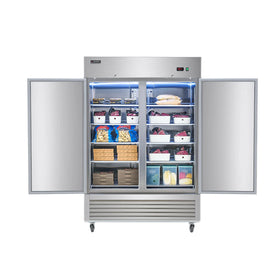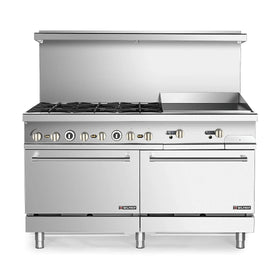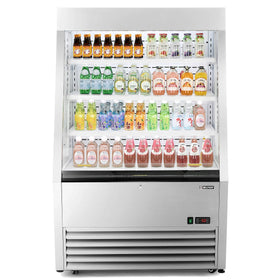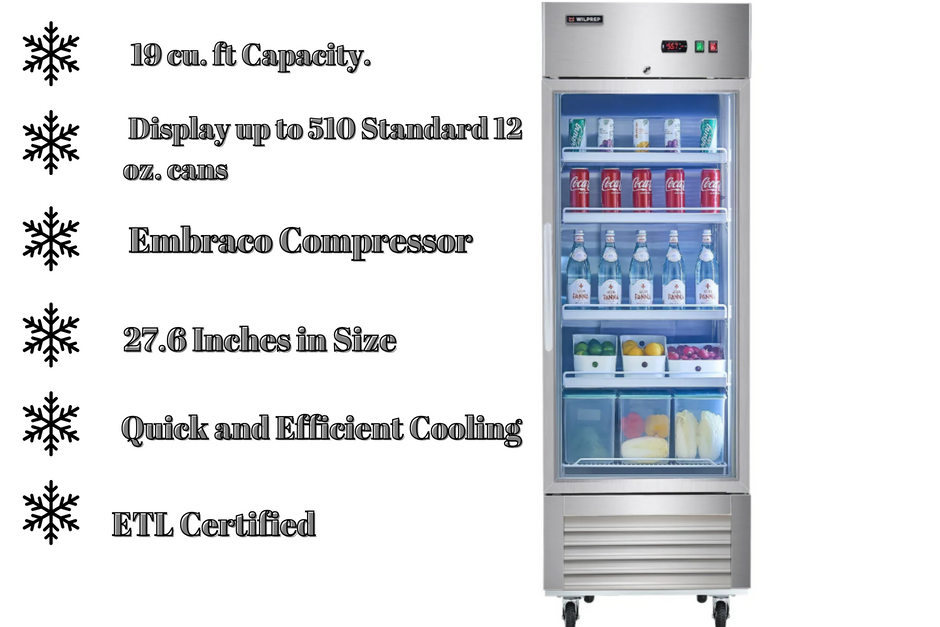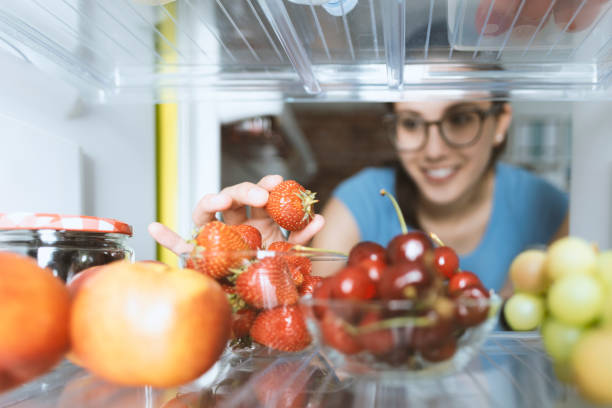Managing a commercial kitchen requires meticulous attention to detail, especially regarding food storage. When it comes to food storage, it does not suffice just to place the food items into a commercial refrigerator. There is actually an established standard practice guiding the process of putting food items in a refrigerator. This “proper way” is critical not only for ensuring food safety but also for maintaining quality and improving overall efficiency in the kitchen. So, what is the proper way of storing foods in a commercial refrigerator, and why must it be adhered to?
SHELF-BY-SHELF GUIDE TO FOOD ARRANGEMENT
TOP SHELF
The top shelf should be reserved for ready-to-eat foods. This includes cooked foods, dairy products (milk, cheese, yogurt), deli meats, prepared salads, and cooked meats.
Reason: Storing ready-to-eat foods on the top shelf ensures that they are kept safe from potential contaminants, which is crucial because they are consumed without further cooking. Raw foods tend to drip juices and bacteria, and since gravity causes liquids to flow downwards, positioning these items on the top shelf eliminates the risk of contamination from raw foods. The top shelf is also often more accessible and visible, which is crucial in a fast-paced commercial kitchen.
UPPER MIDDLE SHELF
The standard practice in every commercial refrigerator is to store prepared foods on the upper middle shelf. This often includes leftovers, pre-cooked meals, and all foods prepped for future cooking which require temporal refrigeration.
Reason: These foods are typically less risky than raw meats but must be kept at safe temperatures. The upper middle shelf ensures that these items are kept at a safe temperature while separated from raw and ready-to-eat foods. This practice helps prevent any potential cross-contamination and maintains the quality of the prepared foods.
LOWER MIDDLE SHELF
All kinds of raw seafood, including fish and shellfish, must be stored on the lower middle shelf.
Reason: Raw seafood is less likely to drip harmful bacteria than raw poultry and meats but must still be separated from ready-to-eat foods.
Though it has a lower risk of bacterial contamination than poultry, raw seafood can still pose a threat if not stored properly. Placing seafood on a lower shelf prevents any possible juices from contaminating the ready-to-eat and cooked foods above. Ensure that seafood is properly wrapped and stored in leak-proof containers to further reduce the risk of contamination.
SECOND TO BOTTOM SHELF
Raw Meat, including Beef, pork, and lamb should all be placed on the shelf that is last to bottom. Raw meats can carry harmful bacteria that need to be contained. Storing them here reduces the risk of their juices contaminating other foods.
Reason: Raw meats, such as beef and pork, should be stored just above the raw poultry to minimize contamination risk further. These meats can harbor dangerous pathogens if they come into contact with other foods. Proper storage in sealed containers or tightly wrapped packaging helps contain any potential contamination.
BOTTOM SHELF
Raw poultry such as Chicken, turkey, and duck go into the bottom shelf.
Reason: Raw poultry is one of the highest-risk items in a commercial refrigerator due to its potential for harboring harmful bacteria like Salmonella and Campylobacter. Storing poultry on the bottom shelf ensures that any leaking juices do not contaminate other foods. Always use leak-proof containers or double-wrap poultry to contain juices and prevent cross-contamination.
CRISPER DRAWERS
Fruits and vegetables including lettuce, tomatoes, apples, and carrots should all go into the crisper drawers. Crisper drawers are designed to maintain humidity levels that help keep produce fresh.
Reason: Fruits and vegetables require specific humidity levels to stay fresh, and crisper drawers are designed to provide this environment. Keeping produce in these drawers can extend their shelf life and maintain their quality. Ensure that fruits and vegetables are washed and dried before storing to prevent mold and bacteria growth.
Door Shelves
The door shelves are ideal for the storage of Condiments and Non-Perishables such as sauces, dressings, and beverages.
Reason: The door is the warmest part of the refrigerator and is subject to temperature fluctuations. Non-perishable items that are less sensitive to temperature changes should be stored here.
The refrigerator door is exposed to room temperature each time it is opened, making it the least stable area for maintaining a consistent temperature. As such, it’s best to store items less sensitive to temperature fluctuations on the door shelves. Condiments, sauces, and beverages fit this category perfectly, as they have preservatives that help maintain their safety and quality.
ADDITIONAL TIPS FOR ORGANIZING A COMMERCIAL REFRIGERATOR
Use Proper Containers and Labels
Containers: Use clear, airtight containers to store food. This not only keeps food fresh but also prevents cross-contamination.
Labels: Clearly label all containers with the contents and the date they were stored. This helps with inventory management and ensures that older items are used first.
Using proper containers helps maintain food's freshness and prevents the mixing of odors and flavors. Labels are essential for organizing food items by their storage dates, which aids in following the First In, First Out (FIFO) method.
Implement First In, First Out (FIFO)
Arrange items so that older products are at the front and newer products are at the back. This practice helps reduce waste and ensures food is used before spoiling.
FIFO is a fundamental principle in food storage management. Ensuring that older stock is used first minimizes waste and reduces the risk of serving spoiled food.
Routine Cleaning
Clean shelves and containers regularly to prevent bacteria and mold buildup. Schedule deep cleanings periodically to maintain a hygienic environment.
Check Temperatures
Use a thermometer to check and record the refrigerator's temperature regularly. To keep food safe, ensure it stays below 40°F (4°C).
A clean refrigerator is crucial for food safety. Regular cleaning prevents the growth of bacteria and mold. Monitoring temperatures ensures the refrigerator operates within the safe range to preserve food quality.
Avoid Overloading
Do not overcrowd shelves, as this can impede proper air circulation and lead to uneven cooling. Proper airflow is essential to maintain consistent temperatures throughout the refrigerator.
Overloading a refrigerator can block air vents and reduce the cooling system's efficiency. Ensure there is adequate space between items to allow for proper air circulation.
Separate Allergens
If your establishment handles allergens (like nuts or shellfish), store them separately and clearly label them to prevent cross-contact with other foods.
Managing allergens is critical in preventing allergic reactions. Clearly labeled storage containers and separate storage areas help avoid cross-contact with other foods.
Practical Implementation
- Inventory Check: Start with an inventory check to know what items you have and their storage requirements.
- Clean and Sanitize: Clean and sanitize the refrigerator before arranging the food items.
Arrange by Categories: Follow the shelf arrangement guidelines to categorize and place food items appropriately.
- Label and Date: Label all items with the date they were stored and any relevant expiration dates.
- Monitor and Adjust: Regularly check the organization, cleanliness, and temperature of the refrigerator. Adjust as necessary to ensure continued food safety and efficiency.
By following these steps, you can ensure that your commercial refrigerator is organized efficiently and safely, reducing the risk of foodborne illnesses and maintaining the quality of your products.
Getting the Right Commercial Refrigerator
Of course, the conversation about food safety always begins with having the right refrigerator. A top-quality commercial refrigerator for your kitchen is the first step to implementing efficient food safety practices. Wilprep’s Kitchen is a global supplier of reliable and durable commercial kitchen equipment, including commercial refrigerators. From reach-in models to open-air models to display merchandisers, Wilprep has supported businesses in all sectors of the food service industry to attain and maintain high standards of food security. Check out some of Wilpreps products and become a customer to benefit from interesting and informative blogs, including tips on how to clean your commercial refrigerator.

